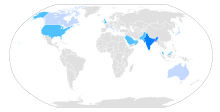Bengali language
| Bengali | |
|---|---|
| Bangla | |
| বাংলা | |

"Bangla" in Bengali script
|
|
| Region | Bengal , Bangladesh, West Bengal, Barak valley, Tripura. |
| Ethnicity | Bengalis |
|
Native speakers
|
210 million (2010) 19 million L2 speakers (in Bangladesh (2011 census)) |
|
Early forms
|
Abahatta
|
| Dialects | |
|
Bengali alphabet Bengali Braille |
|
| Official status | |
|
Official language in
|
|
| Regulated by |
Bangla Academy Paschimbanga Bangla Akademi |
| Language codes | |
| ISO 639-1 | bn |
| ISO 639-2 | |
| ISO 639-3 | |
| Glottolog | beng1280 |
| Linguasphere | |

Geographical distribution of Bengali language in the world
Bengali as only national and official language
Bengali as one of the official languages
Bengali speaking region (1,00,000+)
Bengali speaking region (10,000+)
|
|

Bengali speaking region of South Asia
|
|
Bengali (/bɛŋˈɡɔːli/), also known by its endonym Bangla (/bɑːŋlɑː/; বাংলা [ˈbaŋla]) is an Indo-Aryan language spoken in South Asia. It is the national and official language of the People's Republic of Bangladesh, and the official language of several northeastern states of the Republic of India, including West Bengal, Tripura, Assam (Barak Valley) and Andaman and Nicobar Islands. With over 210 million speakers, Bengali is the seventh most spoken native language in the world.
Although Bengali is an Indo-European language, it has been influenced by other language families prevalent in South Asia, notably the Dravidian, the Austroasiatic, and the Tibeto-Burman families, all of which contributed to Bengali vocabulary and provided the language with some structural forms. Dictionaries from the early 20th century attributed slightly more than half of the Bengali vocabulary to native words (i.e., naturally modified Sanskrit words, corrupted forms of Sanskrit words, and loanwords from non-Indo-European languages), about 45 percent to unmodified Sanskrit words, and the remainder to foreign words. Dominant in the last group was Persian, which was also the source of some grammatical forms. More recent studies suggest that the use of native and foreign words has been increasing, mainly because of the preference of Bengali speakers for the colloquial style. Today, Bengali is the primary language spoken in Bangladesh and the second most spoken language in India.
...
Wikipedia
